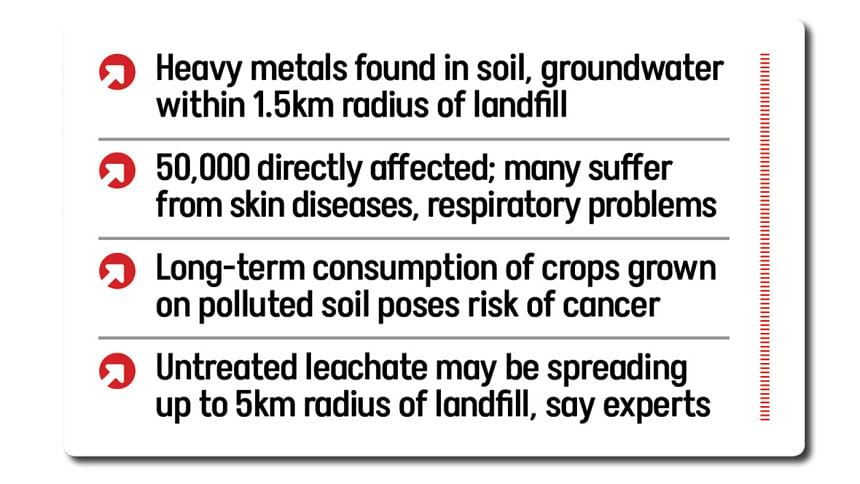Caught in toxic grip of a landfill

The villages around Amin Bazar, once known for their lush green farmlands and fresh air, now stand as stark reminders of unchecked pollution, with locals facing serious health risks from a nearby landfill.
In 2007, Dhaka North City Corporation (DNCC) set up a landfill in Baliarpur of Savar. Since then, Baliarpur, Konda, and Beraith villages in Bangaon union have been facing relentless pollution. The community that once thrived through farming is now grappling with the devastating impacts of water, air, and soil pollution.

According to a study carried out in 2022, leachate, a toxic liquid from decomposing waste, seeps into soil and groundwater, carrying heavy metals like arsenic, nickel, chromium, and lead. These contaminants are linked to cancer and other life-threatening diseases, experts say.
Mostafizur Rahman, a professor of environmental sciences at Jahangirnagar University, who co-led the study, said, "We found toxic metals like arsenic and nickel in both surface and groundwater near the landfill. The highest concentration of metals was found in areas closest to the site, showing how pollutants are infiltrating groundwater."
He said the researchers had collected samples of leachate, surface water, groundwater, soil, and leaves of plants from areas within a 1.5km radius of the landfill.
"The detection of cadmium and nickel in surface water indicates high levels of toxicity," he told The Daily Star.
"In groundwater, the highest concentration of heavy metals was found in areas near the landfill, indicating that these toxic metals are coming from it."
Soil near the landfill has also been polluted, with chromium, a harmful heavy metal, detected at 108.5 milligrams per kg, exceeding the permissible limit of 100 milligrams per kg, said Mostafizur.
"This study provides a picture of how Amin Bazar landfill has become a source of multiple types of pollution," he added.
Prof Shafi Mohammad Tareq, a researcher and teacher of environmental sciences at Jahangirnagar University, said that a properly engineered sanitary landfill must have mechanisms to prevent leachate leakage. However, the Amin Bazar site lacks that and doesn't meet the required standards.
"Though there is a leachate treatment pond at the landfill, it doesn't appear to be functioning properly. Untreated leachate may be spreading across a radius of up to five kilometers."
The nearby Turag River, already contaminated with untreated industrial waste, is further poisoned by the landfill's runoff.
"If river water, contaminated by leachate from the landfill, is used for irrigation, it may jeopardise public health through the food chain."
People who consume crops from these fields over an extended period are at a high risk of developing cancer or long-term health issues, Tareq pointed out.
LIVES IN PERIL
The residents of Konda, Baliarpur, and Beraith villages have been struggling to cultivate land for more than a decade. During the monsoon, rainwater carries waste into nearby fields, scattering plastics, broken glass, and medical debris across the area.
Recounting his ordeal, Mohammad Nazim Uddin, a farmer from Baliarpur, said, "Once the water recedes, we find syringes, shards of ceramics, and scrap metal in our fields. Farmers even get hurt while working the land."
Shahidul Islam, a resident of Konda village, said, "Smoke from burning waste fills the air … My six-month-old daughter has been suffering from asthma. I'm also having respiratory problems."
Even water from many tubewells, once a source of fresh groundwater, turned foul. "We had to dig 350 feet deep to get clean water," he lamented.
Saiful Islam, former chairman of Bangaon union parishad, said that around 50,000 people are directly affected by the landfill.
"Around 40 percent of farmland in low-lying areas has already been damaged. Farmers find it hard to cultivate land ... Diarrhea, skin diseases, and respiratory problems have become prevalent among the villagers," he added.
Vegetables and crops grown on contaminated soil are making their way to markets in Mirpur-1, Hemayetpur, Karwan Bazar and other areas, posing health risks to many.
Mohammad Ali, a vegetable seller at Nagar Kunda Bazar of Baliarpur, said he buys vegetables from areas near the landfill. Vegetables from these areas are also sold to traders in Mirpur-1, Karwan Bazar and Hemayetpur.
Contacted, DNCC Administrator Mohammad Azaz said that a waste-to-energy plant is being constructed in Amin Bazar, which will help tackle pollution in the area. The project is expected to be completed by next year.
"Garbage from the northern part of Dhaka city will be used to generate power, reducing landfill waste by up to 90 percent. Besides, leachate will be managed properly," he told The Daily Star.
In 2021, the DNCC and Bangladesh Power Development Board (BPDB) signed an agreement with Beijing-based China Machinery Engineering Corporation to build the country's first waste-based power plant. It'll generate 42.5 megawatts of electricity from 3,000 tonnes of waste per day, with the BPDB purchasing the power.
While the waste-to-energy plant promises long-term relief, environmental experts emphasise the need for immediate measures, such as leachate containment and regular monitoring of groundwater and soil quality, to safeguard the villagers.

 For all latest news, follow The Daily Star's Google News channel.
For all latest news, follow The Daily Star's Google News channel. 





Comments